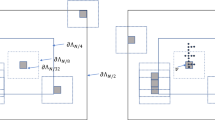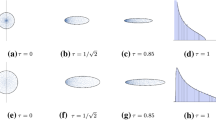Abstract
Let \(\Phi ^h(x)\) with \(x=(t,y)\) denote the near-critical scaling limit of the planar Ising magnetization field. We take the limit of \(\Phi ^h\) as the spatial coordinate y scales to infinity with t fixed and prove that it is a stationary Gaussian process X(t) whose covariance function K(t) is the Laplace transform of a mass spectral measure \(\rho \) of the relativistic quantum field theory associated to the Euclidean field \(\Phi ^h.\)X and K should provide a useful tool for studying the mass spectrum; e.g., the small distance/time behavior of the covariance functions of \(\Phi ^h\) and X(t) shows that \(\rho \) is finite but has infinite first moment.
Similar content being viewed by others
References
Bjorken, J.D., Drell, S.D.: Relativistic Quantum Fields. McGraw-Hill, New York (1965)
Borthwick, D., Garibaldi, S.: Did a 1-dimensional magnet detect a 248-dimensional Lie algebra? Not. Am. Math. Soc. 58, 1055–1066 (2011)
Bricmont, J., Fröhlich, J.: Statistical mechanical methods in particle structure analysis of lattice field theories II. Scalar and surface models. Commun. Math. Phys. 98, 553–578 (1985)
Camia, F., Garban, C., Newman, C.M.: Planar Ising magnetization field I. Uniqueness of the critical scaling limit. Ann. Probab. 43, 528–571 (2015)
Camia, F., Garban, C., Newman, C.M.: Planar Ising magnetization field II. Properties of the critical and near-critical scaling limits. Ann. Inst. Henri Poincaré Probab. Stat. 52, 146–161 (2016)
Camia, F., Jiang, J., Newman, C.M.: Exponential decay for the near-critical scaling limit of the planar Ising model. Commun. Pure Appl. Math. 73, 1371–1405 (2020)
Camia, F., Jiang, J., Newman, C.M.: FK-Ising coupling applied to near-critical planar models. Stoch. Process. Appl. 130, 560–583 (2020)
Chelkak, D., Hongler, C., Izyurov, K.: Conformal invariance of spin correlations in the planar Ising model. Ann. Math. 181, 1087–1138 (2015)
Delfino, G.: Integrable field theory and critical phenomena: the Ising model in a magnetic field. J. Phys. A 37, R45–R78 (2004)
Durrett, R.: Probability: Theory and Examples, 3rd edn. Duxbury, Belmont (2005)
Fernique, X.: Continuité des processus Gaussiens. C. R. Acad. Sci. Paris 258, 6058–6060 (1964)
Folland, G.B.: Real Analysis, Modern Techniques and Their Applications, 2nd edn. Wiley, New York (1999)
Furlan, M., Mourrat, J.-C.: A tightness criterion for random fields, with application to the Ising model. Electron. J. Probab. 22, 1–29 (2017)
Glimm, J., Jaffe, A.: Quantum Physics: A Functional Integral Point of View, 2nd edn. Springer, Berlin (1987)
Griffiths, R.B., Hurst, C.A., Sherman, S.: Concavity of magnetization of an Ising ferromagnet in a positive external field. J. Math. Phys. 11, 790–795 (1970)
Hamedani, G.G., Tata, M.N.: On the determination of the bivariate normal distribution from distributions of linear combinations of the variables. Am. Math. Mon. 82, 913–915 (1975)
Lee, T.D., Yang, C.N.: Statistical theory of equations of state and phase transition. II. Lattice gas and Ising model. Phys. Rev. 87, 410–419 (1952)
Marcus, M.B., Shepp, L.A.: Continuity of Gaussian processes. Trans. Am. Math. Soc. 151, 377–391 (1970)
McCoy, B., Maillard, J.M.: The importance of the Ising model. Prog. Theor. Phys. 127, 791–817 (2012)
Montray, I., Münster, G.: Quantum Fields on a Lattice. Cambridge University Press, Cambridge (1997)
Newman, C.M.: Normal fluctuations and the FKG inequalities. Commun. Math. Phys. 74, 119–128 (1980)
Newman, C.M., Wright, A.L.: An invariance principle for certain dependent sequences. Ann. Probab. 9, 671–675 (1981)
Newman, C.M., Wu, W.: Lee–Yang property and Gaussian multiplicative chaos. Commun. Math. Phys. 369, 153–170 (2019)
Osterwalder, K., Schrader, R.: Axioms for Euclidean Green’s functions. Commun. Math. Phys. 31, 83–112 (1973)
Zamolodchikov, A.B.: Integrals of motion and S-matrix of the (scaled) \(T=T_c\) Ising model with magnetic field. Int. J. Mod. Phys. 04, 4235–4248 (1989)
Zamolodchikov, A.B.: Integrable field theory from conformal field theory. In: Jimbo, M., Miwa, T., Tsuchiya, A. (eds.) Advanced Studies in Pure Mathematics, Integrable Systems in Quantum Field Theory and Statistical Mechanics, vol. 19, pp. 641–674. Mathematical Society of Japan, Tokyo (1989)
Acknowledgements
The research of CMN was supported in part by US-NSF Grant DMS-1507019 and that of JJ by STCSM Grant 17YF1413300. The authors thank Tom Spencer for some useful discussions related to this work.
Author information
Authors and Affiliations
Corresponding author
Additional information
Communicated by Hal Tasaki.
Publisher's Note
Springer Nature remains neutral with regard to jurisdictional claims in published maps and institutional affiliations.
Appendices
Appendix A: \(\Phi ^h\) Paired with a 1-d Delta Function
In [5], it was shown that \(\Phi ^h(f)\) is a well-defined random variable for any f in the Sobolev space \(\mathcal {H}^{-3}(\mathbb {R}^2).\) This was later generalized in [13] to any f in the Besov space \(\mathcal {B}_{p,q}^{-\frac{1}{8}-\epsilon ,\text {loc}}(\mathbb {R}^2)\) where \(\epsilon >0\) and \(p,q\in [1,\infty ].\) But the test function \(1_{[-L,L]}(y)\delta _s(t)\) is in neither of those two spaces. The next lemma justifies the pairing of \(\Phi ^h\) with such a test function.
Lemma A
For any \(\epsilon >0,\) let \(g_{\epsilon }\) be the probability density function of \(N(0,\epsilon )\) (i.e., Gaussian with mean 0 and variance \(\epsilon ).\) For any \(f\in L^1(\mathbb {R})\cap L^2(\mathbb {R}),\) we have that
Remark A
Lemma A holds for more general probability density functions than \(g_{\epsilon };\) we choose a Gaussian distribution to simplify the proof.
Proof
For \(f\in L^1(\mathbb {R})\cap L^2(\mathbb {R}),\) let
Our assumption on f implies \(|h(u)|\le \Vert f\Vert _2\) for each \(u\in \mathbb {R}.\) Therefore,
where the last inequality follows from the exponential decay of H(0, u) for large |u| and \(H(0,|u|)=O(|u|^{-1/4})\) as \(|u|\downarrow 0\) (see Theorem 2).
In the next calculation we use the fact that the random variables \(\Phi ^h(f(y)g_{\epsilon }(t))\) and \(\Phi ^h(f(y)g_{\tilde{\epsilon }}(t))\) have the same expectation, which can be proved with an argument analogous to that used in the proof of Theorem 2 to show that \(\mathbb {E}^h\left( \Phi ^h\left( f_{\epsilon }(t,y)\right) \right) \) is independent of \(\epsilon \):
By the change of variables \(u=y_2-y_1, v=t_2-t_1, w=y_1, x=t_1,\) this equals
where h(u) is as in (54) and \(G_{\epsilon ,\tilde{\epsilon }}:=g_{\epsilon }*g_{\tilde{\epsilon }}\) is the convolution (we have used the fact that \(g_{\epsilon }\) is even). Since \(g_{\epsilon }\) is the density of \(N(0,\epsilon ),\) we have
Another change of variables and using the explicit formula for \(g_{\epsilon }\) give that (57) equals
Note that by the monotonicity of H,
For any \(\eta >0,\) by (55), one may choose \(\xi >0\) and \(N>\xi \) such that
Since
is uniformly continuous on \(\{(u,v):\xi \le |u|\le N, |v|\le N\},\) we have for all small enough \(\epsilon \) and \(\tilde{\epsilon },\)
This combined with (59)–(61) completes the proof of the lemma. \(\square \)
Appendix B: Large Distance/Time Behavior of H and K
In this Appendix, we first derive the large t behavior of \(\hat{H}(t)\) [recall the definition of \(\hat{H}\) in (37)], based on the conjecture that the mass spectrum has an upper gap \((m_1,m_1+\epsilon )\) for some \(\epsilon >0.\) Then, based on this behavior, we prove the (first order) large time behavior for K.
Proposition A
Suppose that \(\tilde{\rho }\left( (m_1,m_1+\epsilon )\right) =0\) for some \(\epsilon >0\) where \(\tilde{\rho }\) is defined in (29). Then there exists a constant \(C_3\in (0,\infty )\) such that
Proof
Using the Källén–Lehmann spectral representation [see (29) and (30)], we have for \(t>0\) that
Recall that the support of \(\tilde{\rho }\) is in \([m_1,\infty ).\) Under the assumption that \(\tilde{\rho }\left( (m_1,m_1+\epsilon )\right) =0\) for some \(\epsilon >0,\) we have
By the change of variables \(y=\sqrt{1+p^2/m^2},\) we get
Using the inequality
we have
On the other hand, the change of variables \(u=\sqrt{t(y-1)}\) gives
Combining (66)–(70), we get that
Therefore,
It is not hard to prove that the last limit is 0 by using the fact that \(\int _{m_1}^{\infty }(1/m)d\tilde{\rho }(m)<\infty \) (see Corollary 1). This, (65) and (71) complete the proof of the proposition. \(\square \)
The power-law correction to the exponential decay in (63) is usually known as Ornstein–Zernike decay (see, e.g., [3, Sect. VII]). It may be possible to prove (63) directly without the assumption of an upper mass gap. Based on this, we have the following large time behavior of K.
Proposition B
Suppose (63) holds. Then we have
We need the following ancillary lemma.
Lemma B
Let \(m>0.\) For any \(\alpha ,\beta \) satisfying \(0<\beta<1/2<\alpha <3/4,\) we have
Proof
We first note that
where we have used the bound (which can be proved by the Cauchy–Schwarz inequality)
in the second inequality, and
in the last inequality. Using the same inequalities, one can show that
Combining (76) and (79), we get
provided the limit on the LHS exists. It is easy to see that
This and (80) prove the first equality in the lemma provided the limit exists. By the Taylor expansion, one can show that there exist constants \(C_4, C_5\in (0,\infty )\) such that for any \(u\in [t^{\beta }, t^{\alpha }]\)
Therefore,
By our assumption on \(\alpha \) and \(\beta ,\) this implies
if the limit on the LHS exists. Since
we have
where we have used the fact that \((1/\sqrt{2\pi t/m})e^{-mu^2/(2t)}\) is the density of N(0, t/m). \(\square \)
Proof of Proposition B
The limit (63) implies that, for any fixed \(\epsilon >0,\)
Lemma B and the definition of K [see (8)] imply that
This completes the proof of the proposition by sending \(\epsilon \downarrow 0\). \(\square \)
Rights and permissions
About this article
Cite this article
Camia, F., Jiang, J. & Newman, C.M. A Gaussian Process Related to the Mass Spectrum of the Near-Critical Ising Model. J Stat Phys 179, 885–900 (2020). https://doi.org/10.1007/s10955-020-02560-w
Received:
Accepted:
Published:
Issue Date:
DOI: https://doi.org/10.1007/s10955-020-02560-w




